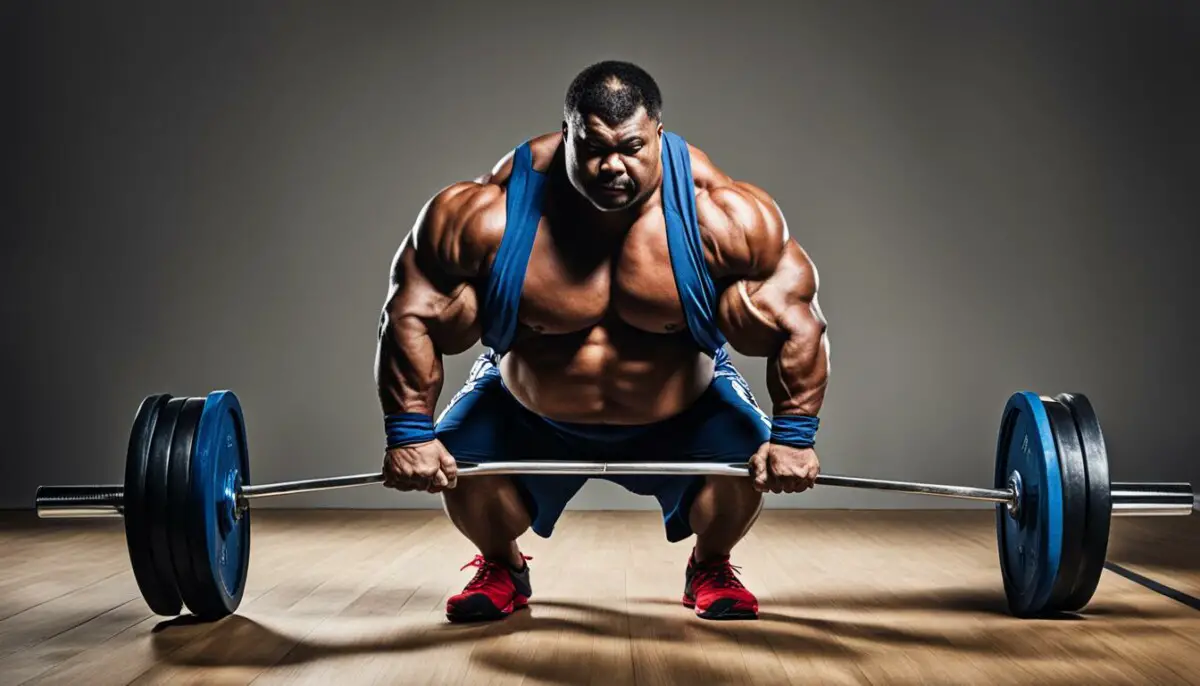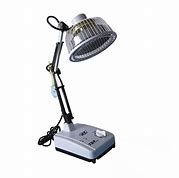Last Updated on 3 months by Francis
The Sumo Deadlift is a powerful compound exercise that offers a range of benefits for strength training. It involves a wider stance and a more upright torso, which targets the quadriceps, glutes, and adductor muscles while still engaging the posterior chain. This variation of the deadlift provides advantages such as increased muscle group engagement, a shorter range of motion, and accessibility for those with limited mobility. By incorporating sumo deadlifts into your routine and using essential accessories like knee sleeves and lifting belts, you can optimize the benefits and elevate your performance in strength training.
Contents
Key Takeaways:
- The sumo deadlift targets the quadriceps, glutes, and adductors, providing excellent muscle group engagement for lower body strength.
- The wider stance in the sumo deadlift allows for a shorter range of motion, making it a viable option for lifters with limited mobility.
- Incorporating sumo deadlifts into your routine can optimize your strength training performance and help you achieve better gains.
- Using accessories like knee sleeves and lifting belts can enhance stability and reduce the risk of injury during sumo deadlifts.
- The sumo deadlift offers a unique variation to the traditional deadlift, allowing for versatility in your strength training program.
Understanding the Sumo Deadlift Technique
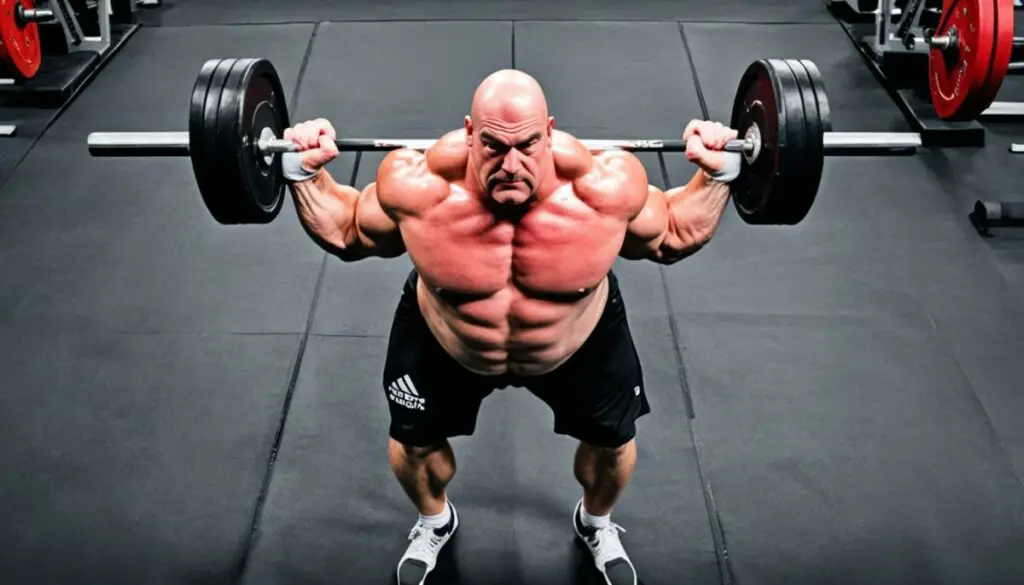
The sumo deadlift is a highly effective exercise for building strength and muscle in the lower body. To perform this lift correctly and maximize its benefits, it’s crucial to understand the proper sumo deadlift technique.
To begin, position yourself with a wider stance, toes pointed outward. This wider stance allows for greater engagement of the quadriceps, glutes, and adductor muscles.
Next, grip the barbell with your hands shoulder-width apart, ensuring your palms are facing inward. This grip helps maintain stability and control throughout the lift.
Once in position, initiate the sumo deadlift by pushing through your heels and driving your hips forward. Simultaneously extend your knees until you’re standing upright. Remember to keep the barbell close to your body throughout the movement to maintain proper form and maximize muscle activation.
When lowering the barbell, hinge at your hips by pushing them back and bending your knees. Lower the barbell until it reaches the floor while maintaining a straight back and engaged core.
Mastering the correct form and technique of the sumo deadlift is essential for reaping the full benefits of this exercise. It ensures optimal muscle recruitment, minimizes the risk of injury, and allows for continued progress in strength and performance.
By incorporating the sumo deadlift into your strength training routine and executing it with proper form, you can develop stronger and more defined lower body muscles while improving overall strength and power.
Key Benefits of Incorporating Sumo Deadlifts into Your Routine

Incorporating sumo deadlifts into your routine offers several key benefits. Firstly, the wider stance and upright torso of the sumo deadlift engage the quadriceps, glutes, and adductors more compared to the traditional deadlift. This helps in strengthening these muscle groups and enhancing overall lower body strength.
Sumo deadlifts also provide a greater range of motion, allowing lifters to handle heavier weights comfortably. By utilizing a wider base and gripping the barbell with hands inside the legs, lifters can generate more power and lift more weight, thereby challenging themselves and promoting muscle growth.
“Sumo deadlifts engage multiple muscle groups and promote overall lower body strength.”
In addition, the sumo deadlift can be a viable option for individuals with limited mobility or specific joint issues. The wider stance reduces the stress on the lower back and hips, making it more accessible and comfortable for those with certain physical limitations.
Overall, sumo deadlifts are an effective exercise for muscle group engagement and strength development. The combination of increased muscle activation, improved range of motion, and accessibility makes sumo deadlifts a valuable addition to any strength training routine.
The Benefits of Sumo Deadlifts:
- Engages quadriceps, glutes, and adductors more than traditional deadlifts
- Enhances lower body strength and muscle development
- Allows for a greater range of motion
- Reduces stress on the lower back and hips
- Accessible for individuals with limited mobility or specific joint issues
By incorporating sumo deadlifts into your workout regimen, you can experience these benefits and take your strength training to the next level.
Essential Accessories and Strategies to Improve Your Sumo Deadlifts
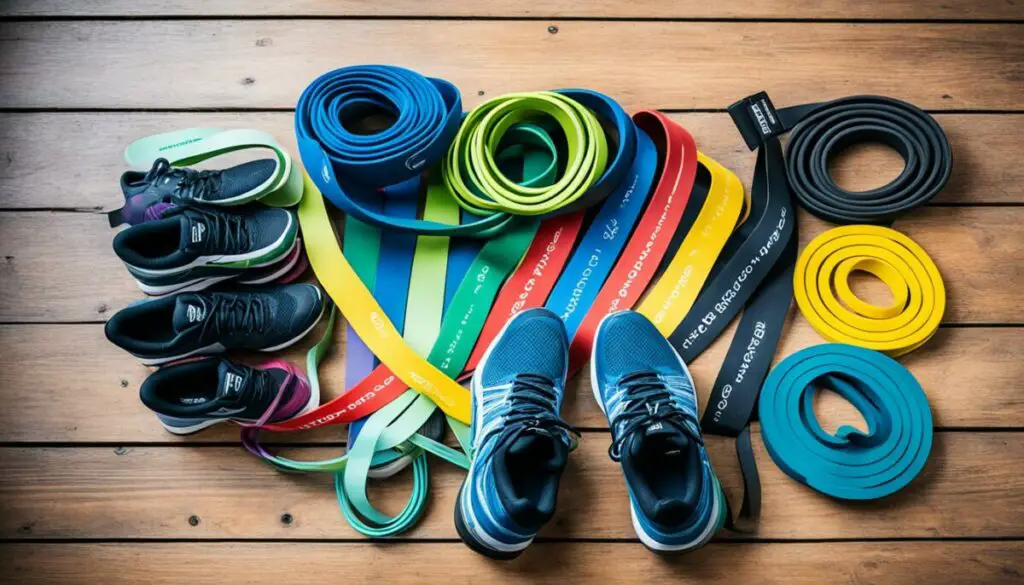
Optimizing your sumo deadlift performance can be achieved with the help of essential accessories and strategies. Incorporating these accessories and techniques into your training routine can enhance your form, prevent injuries, and maximize your results.
Essential Accessories
There are several accessories that can support your sumo deadlift and help you perform at your best:
| Accessory | Benefits |
|---|---|
| Knee Sleeves | Provides support and stability to the knees, reducing the risk of injury during heavy lifts |
| Lifting Belts | Offers core and lower back support, promoting proper lifting technique and preventing strain |
| Grips (Straps and Chalk) | Enhances grip strength, allowing for better control of the barbell and increased performance |
| Barbell Jack | Makes loading and unloading plates effortless and safe, saving time and energy |
By incorporating these accessories into your training, you can enhance your stability, grip, and overall performance during sumo deadlifts.
Strategies to Improve Your Sumo Deadlifts
In addition to using accessories, implementing certain strategies in your training routine can also improve your sumo deadlift technique and results:
- Progressive Overload: Gradually increase the weight you lift to challenge your muscles and stimulate strength gains.
- Focusing on Form: Paying attention to proper form and technique will optimize muscle activation and reduce the risk of injury.
- Variation Exercises: Incorporate variation exercises like pause deadlifts or Romanian deadlifts to target specific weaknesses and add variety to your training routine.
By combining these strategies with the use of accessories, you can effectively improve your sumo deadlift performance and achieve your strength training goals.
Additional Tips for Sumo Deadlift Success
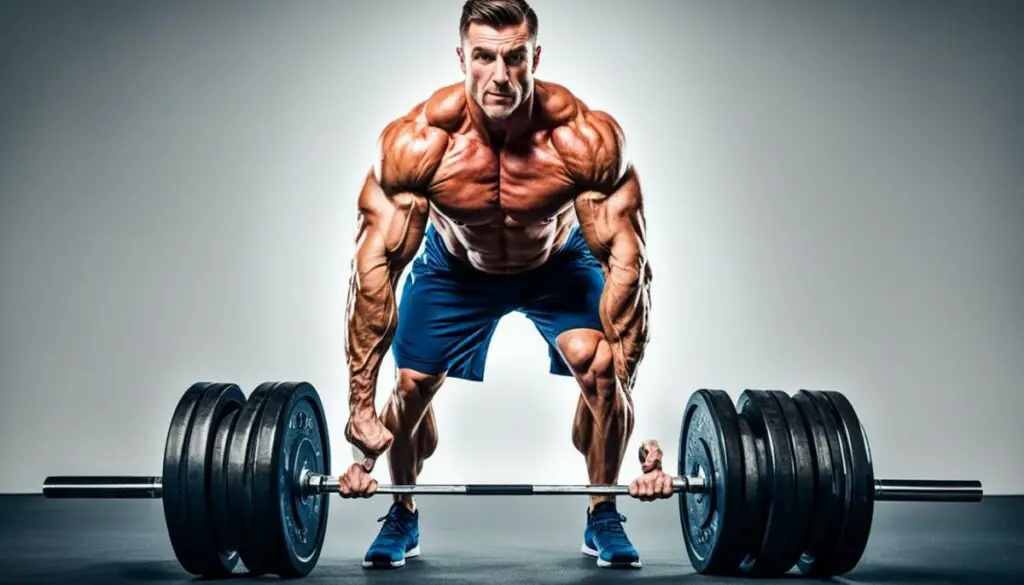
To further enhance your progress in sumo deadlifts, here are some additional tips that can help you optimize your performance and achieve success in your training.
1. Gradually Increase Weight, Volume, or Intensity
Implementing progressive overload is crucial for consistent strength gains and muscle growth in your sumo deadlifts. Gradually increase the weight you lift, the volume of your training sessions, or the intensity of your lifts to challenge your body and stimulate progress.
2. Emphasize Proper Technique
Proper technique is essential for optimal muscle activation, injury prevention, and steady progress in sumo deadlifts. Focus on maintaining a neutral spine, engaging your core, and hinging at the hips correctly with each repetition. Performing each lift with precision and attention to form will yield better results over time.
3. Incorporate Variation Exercises
Diversify your strength training routine by incorporating variation exercises that target specific deadlift weaknesses. Try exercises like pause deadlifts or Romanian deadlifts to focus on different aspects of the lift and develop a well-rounded strength foundation.
Remember, progress in sumo deadlifts takes time and consistency. By gradually increasing the weight, volume, or intensity, emphasizing proper technique, and incorporating variation exercises, you can maximize the benefits of sumo deadlifts and achieve success in your training.
Stay focused, stay motivated, and keep pushing your limits to reach new heights in your sumo deadlift journey!
| Tips for Sumo Deadlift Success |
|---|
| Gradually increase weight, volume, or intensity |
| Emphasize proper technique |
| Incorporate variation exercises |
Sumo Deadlift: Elevate Your Performance with the Right Techniques and Accessories
The sumo deadlift is a highly beneficial exercise that can greatly enhance your weightlifting performance. By mastering the sumo deadlift technique and utilizing the right accessories, you can optimize muscle engagement, improve form, decrease the risk of injury, and maximize efficiency during your sumo deadlift sessions.
Mastering Sumo Deadlift Techniques
Proper technique is crucial for maximizing the benefits of the sumo deadlift. Here are some key techniques to focus on:
- Wide Stance: Stand with a wider stance compared to the conventional deadlift. This allows for greater engagement of the quadriceps, glutes, and adductor muscles.
- Toes Outward: Point your toes slightly outward to allow for better hip mobility and balance.
- Hand Placement: Grip the barbell with your hands positioned shoulder-width apart, inside your legs, ensuring a strong and secure grip.
- Engage Your Core: Activate your core muscles throughout the lift to maintain stability and protect your lower back.
- Upright Torso: Keep your torso more upright compared to the conventional deadlift, putting less strain on your lower back.
By focusing on these techniques, you’ll be able to perform the sumo deadlift with optimal form and efficiency.
Optimizing Performance with Accessories
In addition to correct technique, using the right accessories can further enhance your performance in sumo deadlifts. Consider incorporating the following equipment:
“Using the right accessories can make a significant difference in your sumo deadlift performance. Don’t underestimate their impact!”
| Accessory | Description |
|---|---|
| Knee Sleeves | Provide support and stability to your knees, reducing the risk of injury. |
| Lifting Belts | Offer core and lower back support during heavy lifts, promoting a secure lifting experience. |
| Grips (straps, chalk) | Improve grip strength, allowing for better control of the barbell. |
| Barbell Jack | Simplify the loading and unloading of plates, making your training sessions more efficient. |
By utilizing these accessories, you can optimize your sumo deadlift performance and minimize the risk of unnecessary strain or injury.
Remember, mastering the sumo deadlift technique and utilizing the appropriate accessories are essential for maximizing the benefits of this exercise and unlocking your full potential in the world of deadlifting.
Sumo vs. Conventional Deadlifts: Which Lift Reigns Supreme?
The sumo deadlift and conventional deadlift are two popular variations of the deadlift exercise. Understanding the differences between these two lifts can help determine which one is best suited for your goals.
The sumo deadlift involves a wider stance and emphasizes the quadriceps, glutes, and adductors. This stance allows for a more upright torso and targets these muscle groups to a greater extent. On the other hand, the conventional deadlift has a narrower stance and places more emphasis on the glutes, hamstrings, and lower back. The narrower stance and hip positioning during the conventional deadlift engage these muscle groups more significantly.
The choice between sumo and conventional deadlift should be based on individual biomechanics, personal preference, and training goals. Some lifters may find the sumo deadlift more effective for targeting their quads and adductors, while others may prefer the conventional deadlift for its focus on the glutes, hamstrings, and lower back. It’s important to experiment with both variations and assess which one feels more natural and allows for better lifting technique.
Key Differences Between Sumo and Conventional Deadlifts:
- The stance: Sumo deadlift has a wider stance, while conventional deadlift has a narrower stance.
- Targeted muscles: Sumo deadlift emphasizes the quadriceps, glutes, and adductors, while conventional deadlift targets the glutes, hamstrings, and lower back.
Ultimately, the choice between sumo and conventional deadlift depends on individual factors and preferences. It’s essential to focus on proper form and technique while performing either variation to maximize benefits and minimize the risk of injury.
| Sumo Deadlift | Conventional Deadlift |
|---|---|
| Wider stance | Narrower stance |
| Targets quadriceps, glutes, and adductors | Targets glutes, hamstrings, and lower back |
| Provides a shorter range of motion | Requires a longer range of motion |
| Engages the posterior chain | Places more stress on the lower back and hamstrings |
| May be more accessible for those with limited mobility | Requires greater mobility and flexibility |
How To Do Sumo Deadlifts
Performing sumo deadlifts correctly is crucial for maximizing the benefits of this exercise. Follow the step-by-step guide below to ensure proper form and technique:
- Start by placing the barbell on the floor and standing with a wide stance, toes pointed outward.
- Bend down and grip the barbell with hands inside the legs. Your hands should be shoulder-width apart.
- Engage your core and keep your chest up. This will help maintain a straight back throughout the lift.
- Initiate the lift by extending your hips and knees, pushing through the heels. The barbell should stay close to your body as you lift.
- Lower the barbell by hinging at the hips and bending the knees, while keeping your back straight. Maintain control throughout the descent.
- Practice proper form and technique to ensure optimal muscle activation and reduce the risk of injury.
Remember to start with lighter weights until you feel comfortable with the movement. Gradually increase the weight as you gain confidence and strength.
Proper form and technique are key to performing sumo deadlifts effectively. Take the time to master each step and seek guidance from a qualified trainer if needed.
What Are the Performance Differences between the Sumo Deadlift and the Conventional Deadlift?
The sumo deadlift and the conventional deadlift are two variations of the deadlift exercise that differ in foot positioning and stance width. Understanding the performance differences between these two lifts can help you determine which one best suits your goals and biomechanics.
The sumo deadlift involves a wider stance, with the feet positioned wider than shoulder-width apart and pointing outward. This wider stance is advantageous for individuals with long legs and a short torso as it allows for a more upright torso position, reducing the range of motion and placing less stress on the lower back. The wider stance also places more emphasis on the quadriceps, making it beneficial for those looking to target and strengthen these muscles.
In contrast, the conventional deadlift is performed with a narrower stance, with the feet positioned approximately hip-width apart. This narrower stance is beneficial for individuals with a long torso and short legs as it allows for a greater engagement of the glutes, hamstrings, and lower back. The narrower stance also requires a greater range of motion, making it ideal for those looking to develop overall posterior chain strength and power.
In terms of muscle activation, both the sumo deadlift and the conventional deadlift engage similar muscle groups, including the glutes, hamstrings, and lower back. However, the sumo deadlift places more emphasis on the quadriceps due to the wider stance, while the conventional deadlift targets the hamstrings and lower back to a greater extent.
“The sumo deadlift emphasizes the quadriceps and requires less range of motion, while the conventional deadlift targets the hamstrings and lower back more intensely.”
Another significant difference between the sumo deadlift and the conventional deadlift is the stress placed on the spine and knees. Due to the wider stance and upright torso position, the sumo deadlift typically puts less stress on the spine and knees compared to the conventional deadlift. This can be beneficial for individuals with pre-existing back or knee issues, as it reduces the risk of exacerbating these conditions.
Overall, the performance differences between the sumo deadlift and the conventional deadlift primarily lie in foot positioning, stance width, and the emphasis on different muscle groups. Understanding these differences can help you select the most appropriate deadlift variation based on your goals, body proportions, and individual needs.
Conclusion
The sumo deadlift offers numerous benefits for strength training. By incorporating sumo deadlifts into your routine and utilizing essential accessories, you can optimize your performance and maximize strength gains. This exercise targets multiple muscle groups, including the quadriceps, glutes, and adductors, resulting in increased muscle group engagement. It also provides an improved range of motion, allowing you to handle heavier weights comfortably.
In addition to the physical benefits, sumo deadlifts are accessible for individuals with limited mobility. The wider stance and more upright torso reduce strain on the lower back and knees, making it a suitable option for those with specific joint issues. To further enhance your sumo deadlift success, it is essential to follow tips such as progressive overload and proper form. These strategies can help you achieve steady progress and minimize the risk of injury during your training.
Whether you choose to perform sumo deadlifts or conventional deadlifts, understanding the differences and utilizing the appropriate techniques and accessories should be based on your individual biomechanics, personal preference, and training goals. Ultimately, incorporating sumo deadlifts into your fitness routine can contribute to your overall strength training journey and help you achieve your desired results.
FAQ
What are the benefits of sumo deadlift?
Sumo deadlift offers benefits such as increased muscle group engagement, a shorter range of motion, and accessibility for those with limited mobility.
How do I perform a sumo deadlift?
Stand with a wider stance, toes pointed outward, and grip the barbell with hands shoulder-width apart. Initiate the lift by pushing through the heels, extending the hips and knees, and keeping the barbell close to the body. Lower the barbell by hinging at the hips and bending the knees while maintaining a straight back and engaged core.
What are the key benefits of incorporating sumo deadlifts into my routine?
The wider stance and upright torso of the sumo deadlift engage the quadriceps, glutes, and adductors more compared to the traditional deadlift, improving lower body strength. Additionally, sumo deadlifts provide a greater range of motion and are more accessible for individuals with limited mobility.
How can I improve my sumo deadlifts?
Use essential accessories like knee sleeves and lifting belts for support and stability. Implement strategies like progressive overload, focusing on form, and incorporating variation exercises to enhance your sumo deadlift technique and results.
Any additional tips for sumo deadlift success?
Gradually increase weight, volume, or intensity through progressive overload. Emphasize proper technique and include variation exercises like pause deadlifts or Romanian deadlifts to target specific weaknesses and diversify your strength training routine.
How can sumo deadlift techniques and accessories elevate my performance?
Mastering sumo deadlift technique and utilizing accessories like knee sleeves, lifting belts, grips, and the Barbell Jack optimize muscle engagement, improve form, decrease the risk of injury, and enhance efficiency during sumo deadlift sessions.
What differentiates the sumo deadlift from the conventional deadlift?
The sumo deadlift involves a wider stance, targeting the quadriceps, glutes, and adductors. The conventional deadlift has a narrower stance, focusing on the glutes, hamstrings, and lower back. The choice between the two should be based on individual biomechanics, personal preference, and training goals.
How do I perform sumo deadlifts correctly?
Place the barbell on the floor and stand with a wide stance, toes pointed outward. Bend down, grip the barbell with hands inside the legs, engage your core, keep your chest up, and lift the barbell by extending the hips and knees while maintaining a straight back. Lower the barbell by hinging at the hips and bending the knees while keeping the back straight.
What are the performance differences between the sumo deadlift and the conventional deadlift?
The sumo deadlift with a wider stance is advantageous for individuals with long legs and a short torso. The conventional deadlift with a narrower stance benefits those with a long torso and short legs. Muscle activation is relatively similar between the two lifts, but the sumo deadlift places more emphasis on the quads, while the conventional deadlift targets the hamstrings and lower back.
What are the overall benefits of sumo deadlift?
Sumo deadlifts provide increased muscle group engagement, improved range of motion, and accessibility for individuals with limited mobility. By incorporating sumo deadlifts into your routine and utilizing essential accessories, you can optimize your strength training workouts and achieve your fitness goals.

